

Culture plays an important role in the development of any nation. It represents a set of shared attitudes, values, goals and practices. Culture and creativity manifest themselves in almost all economic, social and other activities. A country as diverse as India is symbolized by the plurality of its culture. In India, some of the arts were invented to connect the human to god, and because of that, the value of art becomes more precious. Some of the arts are worshiped like God and are still considered holy and sacred. If you go long years back, you will realize that there was no tool to record the golden history except for paintings. And that was the time when Pichwai Paintings got into existence. Every style of painting holds its own unique story, so does Pichwai Paintings .
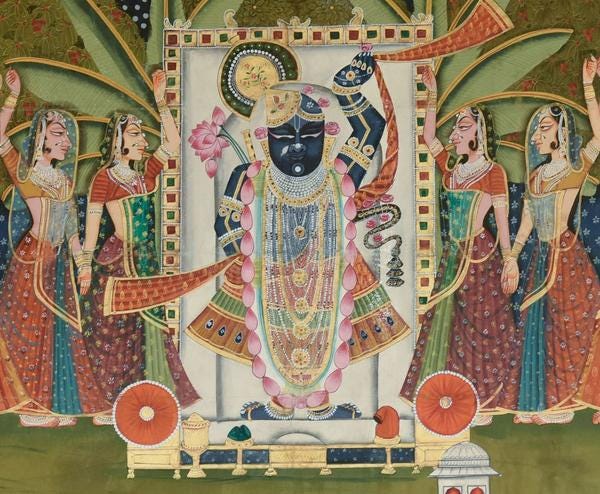
For a person brought up in India, it’s not uncommon to have grown up listening to the glorious stories of Lord Krishna. The stories of Krishna, especially the tales of his childhood, make up a significant and beautiful part of Indian culture and history. From books to movies and different kinds of media, these tales are everywhere. However, not many know that there is an art form specialized particularly to depict these tales of Krishna. This is a Pichwai Painting. The central theme of Pichwai Paintings revolves around the stories of experiences of Lord Krishna, majorly from his early years. The Principal hanging which is suspended behind the image or idol of Lord Krishna and acts as a stage backdrop for the ceremony is called the Pichwai. The term Pichwai is a Hindi word ,literally meaning “of behind “(pich-back and wai -of ) A traditional art form practiced in Nathdwara, Rajasthan, the Pichwai is an intricate painting that depicts theatrical scenes from Lord Krishna’s life, typically hung behind the sanctum of his own manifestation, Shrinathji. These elaborate textile hangings celebrate joyous adoration for Lord Krishna, and were originally designed to create a devotional atmosphere for the daily ‘shringaar’ — the special adornment of the deity. .Apart from being a visual narrative, they also express the mood of the deity, the spirit of the season or festival.
Pichwai Paintings are scrupulously detailed big-sized paintings done on fabric using dark, rich hues, are designed to create a devotional atmosphere for the joyous adoration of Lord Shrinathji.
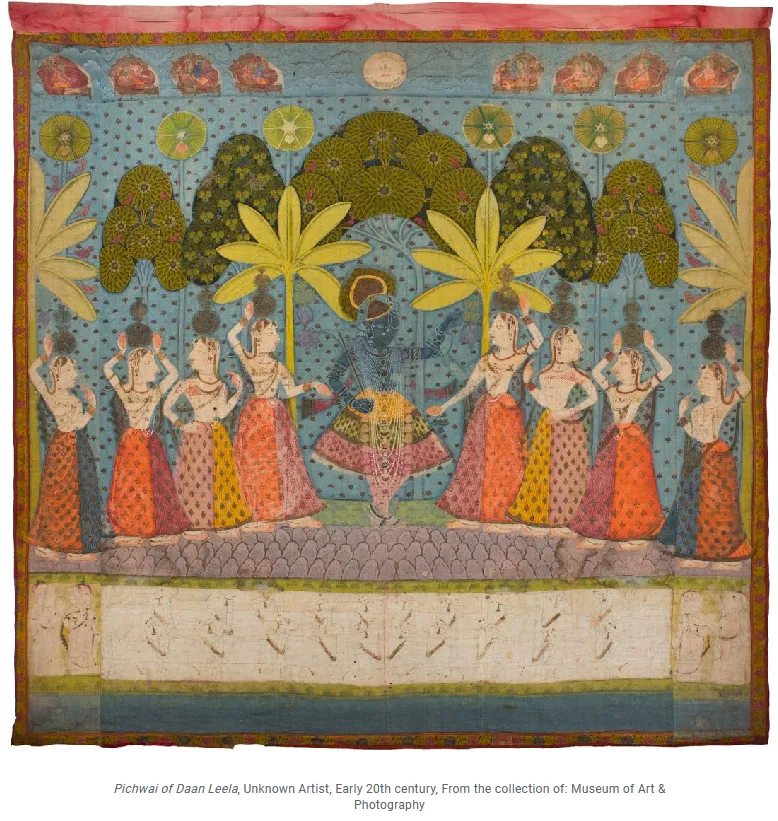
The story of Krishna presents in itself a blend of legend and symbolism. The numerous incidents associated with his life are integral to India’s cultural and religious ethos, particularly in Vaishnava-Hindu worship across the country. However, the Pichwai, in keeping with the core values of Vallabh’s philosophies focus primarily on events from Krishna’s youth, drawing inspiration from the Bhagavata Purana.
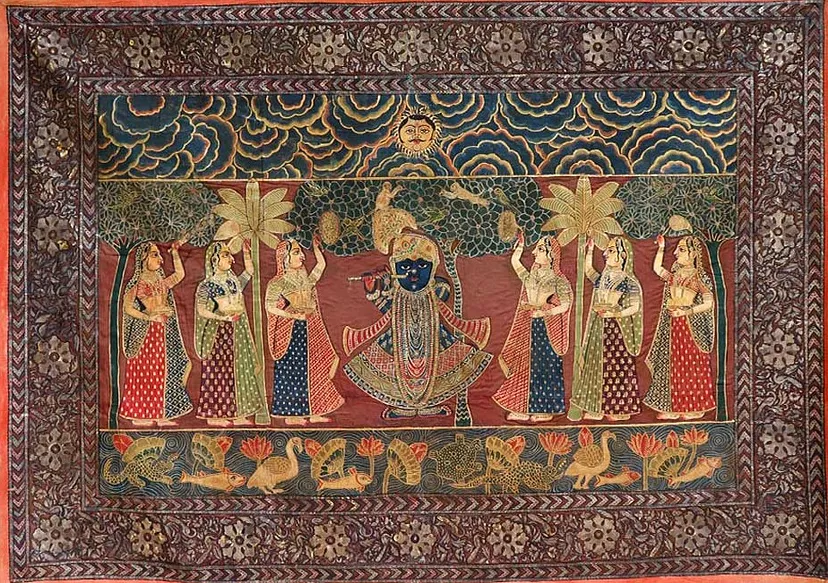
It is difficult to determine when Pichwais were first used in the temples of the sect .Two early references to the hangings were found in the time of Vittalnath .The words Pichwai ,Pichwari as well as simhasana were used in describing the decoration for Varsha or rainy season and phula mandali or flower gathering festival .These references indicate that the custom of decorating the shrine with cloth hangings has been a part of the rituals since the times of Vittalnath .whether Pichwai were used earlier during Vallabh Acharya’s time is questionable .The size and shape of the Pichwai was dictated by the dimensions of the shrine and the type of image for which it was made .
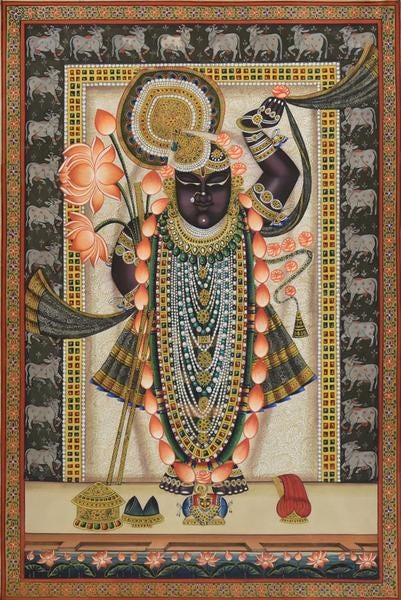
Krishna as Shrinathji
In the 15th century, perhaps as a reaction to the increasingly ascetic direction in which Hinduism was going, there was born in North India, a new off-set of Krishna worship called the Pushti Marg, or the Path of Grace. The Pushti Marg lays claim to a distinctive culture — reaching back centuries and still vital today — in which art and devotion are deeply intertwined. An introduction into their resplendent visual world, this exhibit explores the unique aesthetic tradition of the Pichwai.
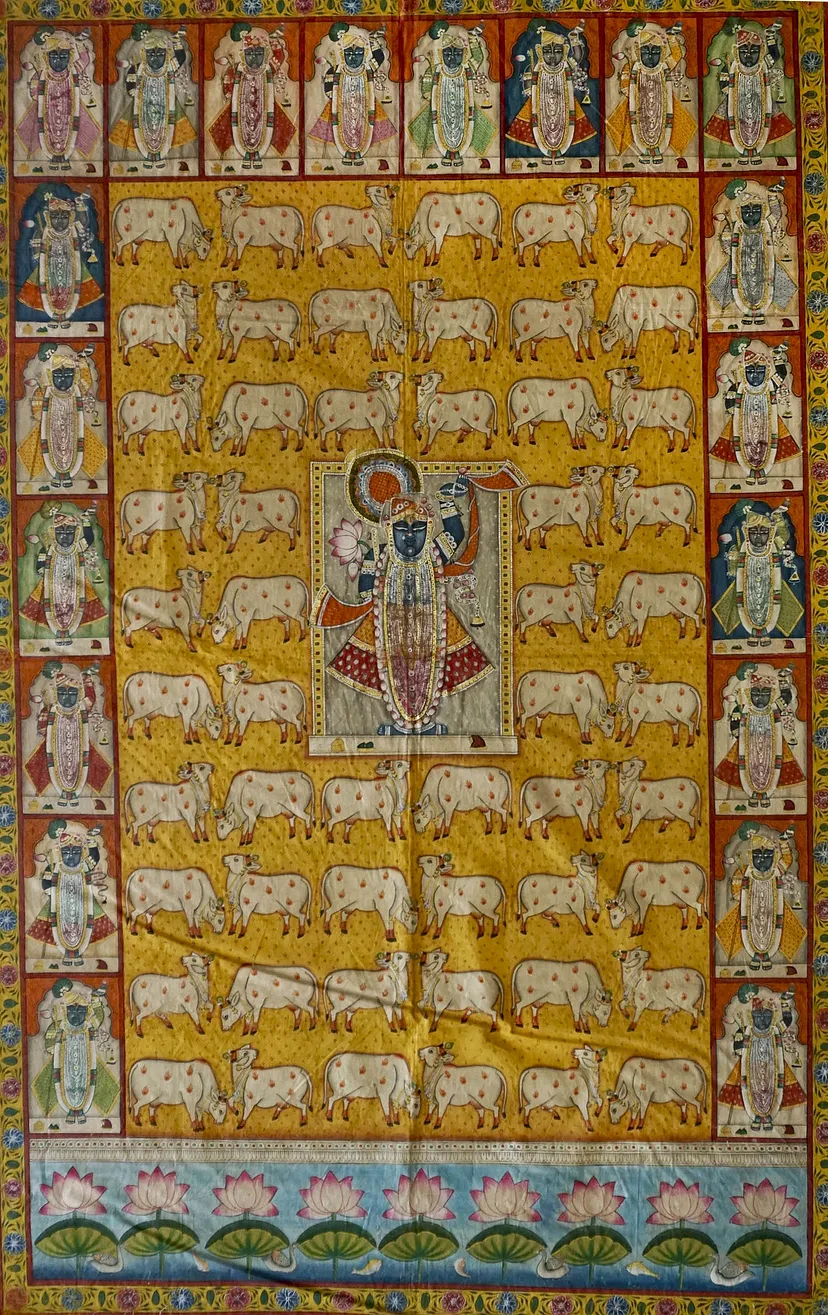
The Pushti Marg or Path of Grace was founded by Vallabh Acharya, one of the six main acharyas of the Bhakti tradition in India, at the turn of the 16th century
Unlike many other religious sects, the Pushti Marg does not advocate asceticism as a path to enlightenment, believing instead that the true spiritual goal is achieved through personal devotion and surrender to Krishna in the midst of worldly pursuits and pleasures. Due to its philosophical belief of monism, or Shuddhadvaitam, the Pushti Marg maintains that all existence is derived from a single Supreme Power and that all living beings carry its essence within them. The soul’s awareness of its oneness with the Almighty, then, comes only through God’s grace (Pushti) and the revelation of Himself in His divine play (Lila) — the path to which lies in the adoration of Krishna (bhakti). This adoration is particularly centered around Shrinathji — the youthful manifestation of Krishna, who Vallabacharya believed to be the most complete incarnation of Vishnu. Thus, the childhood sports (lilas) of Krishna among his cowherd friends on the banks of the Yamuna, is believed to be the most potent and divine play of the Lord, allowing devotees to partake in the highest degree of divine bliss.
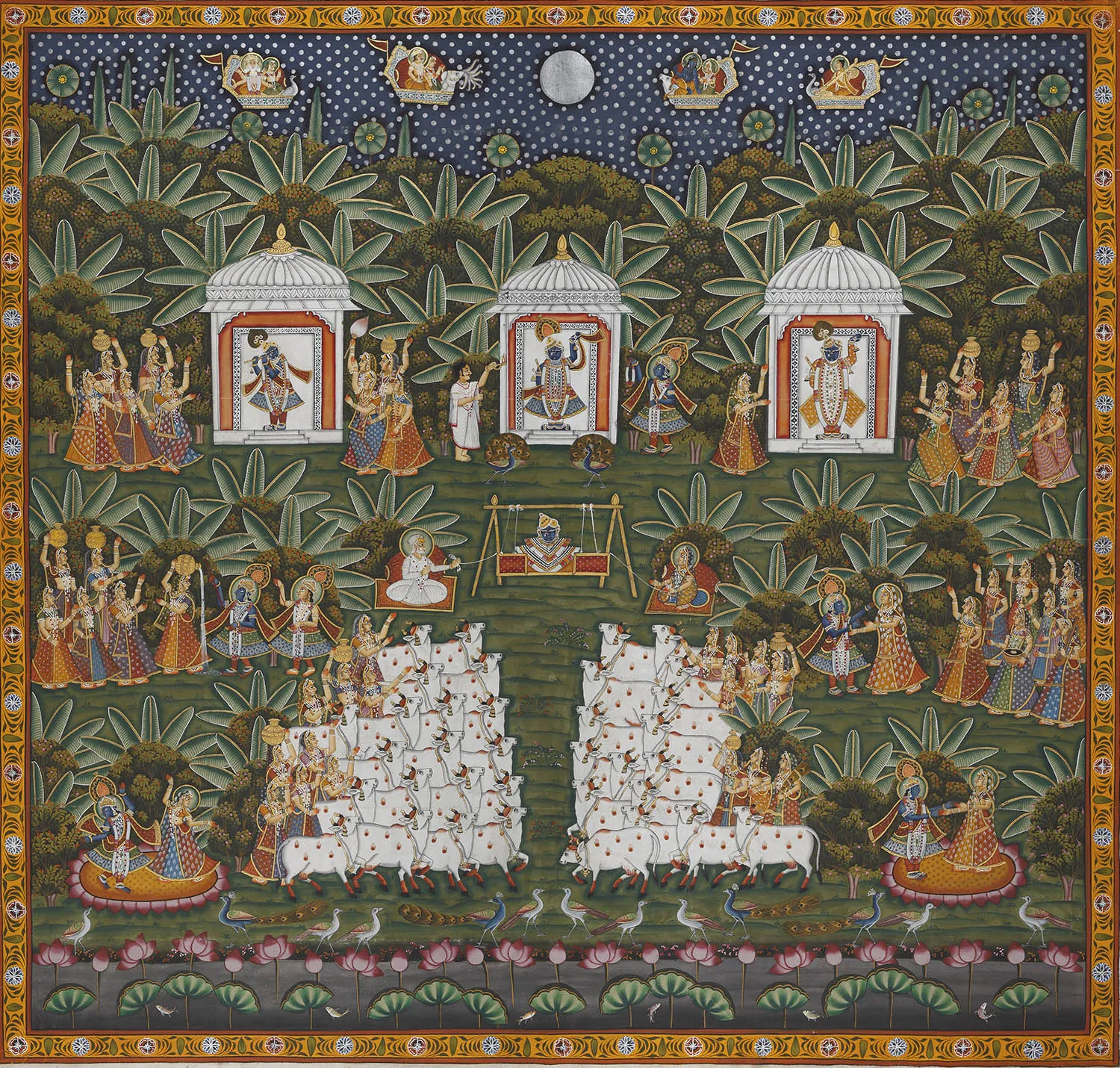
According to the popular legend, Krishna as a child lifted the Govardhan Parvat on his little finger to save the villagers of Vrindavan from the thunderstorms and flood. This episode of Krishna’s life is portrayed in Shrinathji’s posture with deity’s left hand raised while rest hand is bent to shower blessings.
Mythology
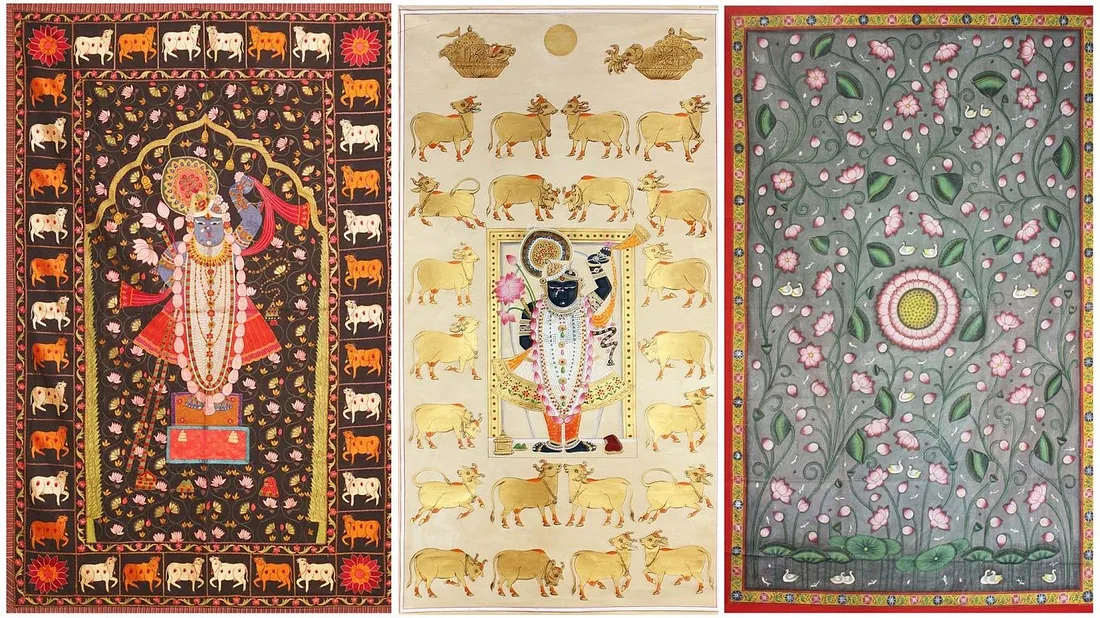
When Indra, the lord of rains, showed his wrath on the people of Vrindavan, with violent rains and thunder, lord Krishna lifted the Govardhan Mountain like an umbrella and saved the inhabitants — the cows and cowherds, from Indra’s fury. Indra was humbled and the people started worshipping Govardhan, the giver of rains and green pastures. Legend has it that in 1409 AD, an image of lord Shrinathji, the mountain lifting form of Krishna, was discovered when a cow worshipped the lord with offerings of milk. A temple was established there and was held in high reverence.
Shrinathji’s idol was brought to Rajasthan from Govardhana near Vrindavan to protect it from the hands of the Mughal emperor Aurangzeb who in 1665 was bent upon vandalizing the area of Vrindavan by widespread destruction of Hindu temples. When the Mughal army came to Govardhana, the devotees of the Lord showed them the titles and gifts given to the temple by the previous Mughal rulers. The army commander then ordered the deity to be taken away from Govardhana. For almost six months the statue stayed in Agra after which the custodians of the idol of Shrinathji left that place with the idol in search of a new heaven.
Srinathji Haveli -Nathdwara
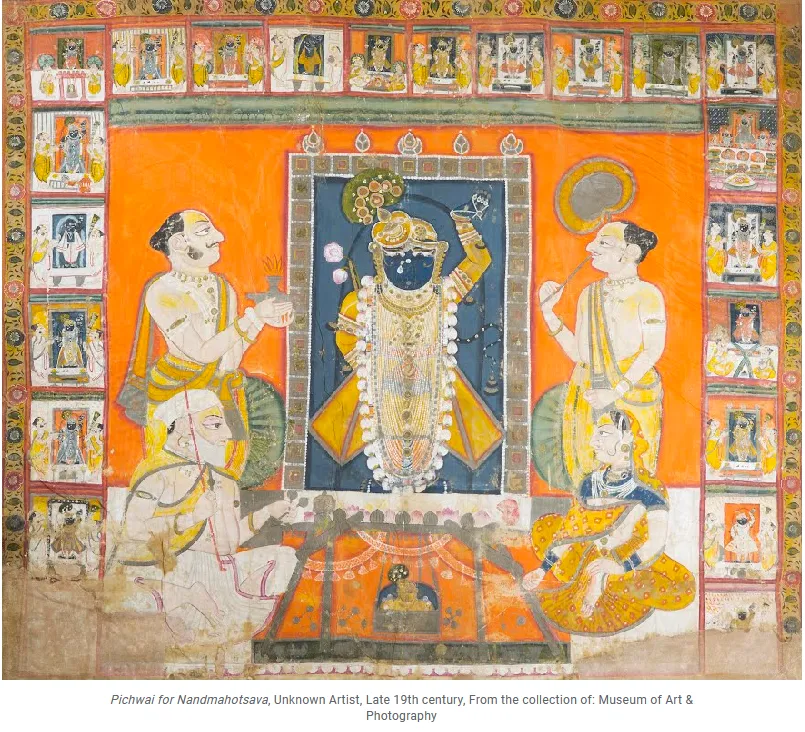
While several other princes were diffident, it was Maharana Rajsingh of Mewar who dared to provide refuge. Along with the idol of Shrinathji, the lord’s sevaks — the priests, halwais (confectioners), cows and their care takers and the Pichwai painters (painters of temple background art) also went along. They stopped at Eklingji in Rajasthan, where there was a momentous temple of Shiva, but since two temples of great importance cannot exist in one city, they moved on further. The decision to settle the Lord here at Nathdwara involves an interesting story. When the wheel of the chariot carrying the Lord got stuck in the mud at a place called Sihar, the Rana saw it as a divine sign that Lord Krishna wished to settle here, and thus a temple was built at this spot and the holy township of Nathdwara grew around the temple . Nathdwara, (Nath — Lord, dwara — gate) meaning “the gates of the lord”.
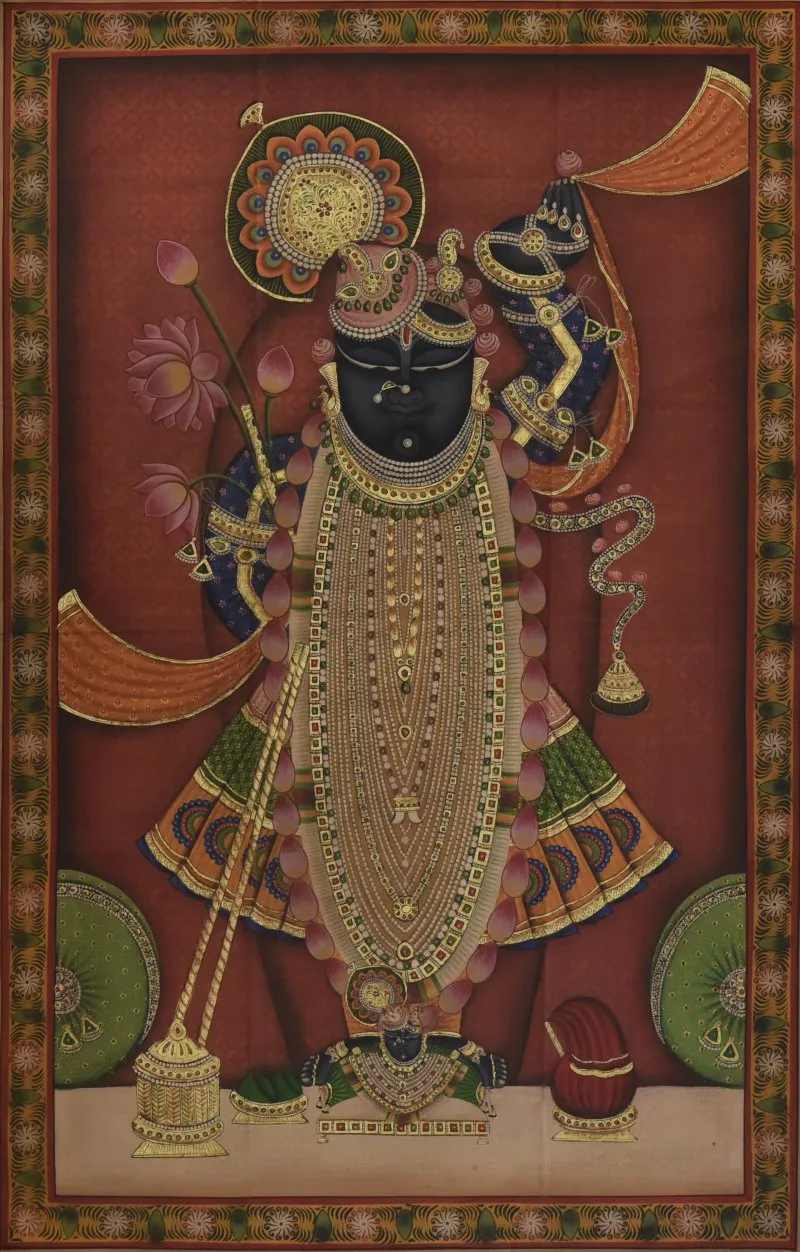
The idol went on a journey to Mewar which took 32 months to complete. The image of Shrinathji, a child manifestation of Krishna,Popularly known as Lord Shrinathji was placed in a new Temple built in village Sihar, now called Nathdwara, on the banks of river Banas in 1670 by Goswami priests from Mathura. After this, many artists, including the famous Acharya Gopinathji, motivated by religious fervor came and created paintings of Srinathji.
Next, during the 16th century, not soon after the construction of Nathdwara temple was completed, the local artists began the decorations of the temple. One such decoration came about to be Pichwais. Communities of artists started creating embroidered and painted illustrations of events from Lord Krishna’s life. The velvet cloths were intricately decorated with a hand in threads and embellishments of a royal kind and then hung on the walls of the temple. In those days, decorating the temples with handmade pichwai paintings became an eternal ritual. These paintings made on large cloths show Lord Krishna as Shrinathji and depict his childhood.The pichwais are changed daily, seasonally, and for various rituals and festive occasions in the temple. They create the setting for all related seva and as such depict key events significant to the Vallabha sampradaya or doctrine. These elaborate textile hangings celebrate joyous adoration for Lord Krishna, and were originally designed to create a devotional atmosphere for the daily ‘shringaar’ — the special adornment of the deity.
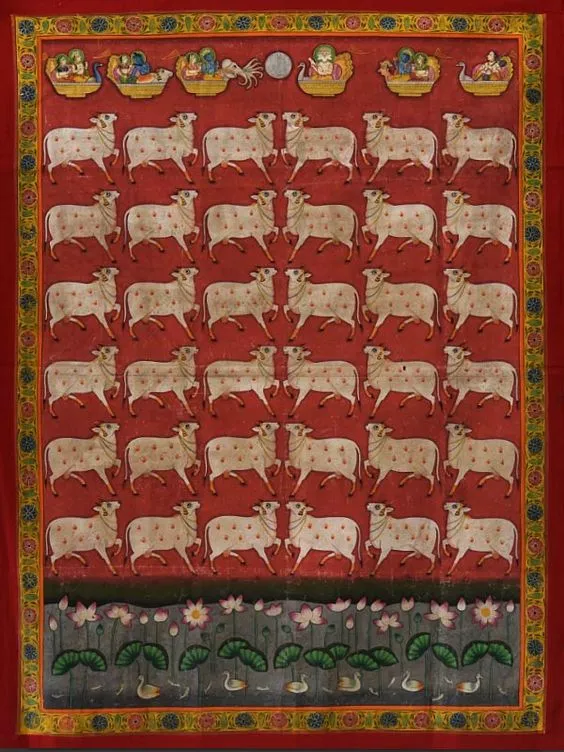
Shrinathji, a form of Lord Krishna manifest as a seven-year-old child is a dominant figure in Pichwai art. They are exuberant outpourings of adoration for Krishna that add a visual dimension to the already elaborate sewa or service to Shrinathji. Painted on cotton; made of brocade and heavy silk; embroidered; painted and dyed; tinsel printed; block printed; even made of machine-made lace — they also constitute a resplendent addition to the unique textile arts of India. The pichwais are multilayered with respect to the Pushti Marg seva (worship), constituting on the one hand the day-to-day adornment of the sanctum sanctorum of the shrine; while on another level they are deeply symbolic — artistic expressions of deep religious faith and devotion that embody and impart the bhava or mood in the shrine and among devotees. Part theatrical backdrop, part religious icons, they are made manifest by the celebratory spirit and desire to surround Krishna with all the luxuries and comforts available, rooted in the tenets of the sect. Although pichwais were usually made in Rajasthan and Gujarat, a few examples from the Deccan, as well as machine-made roller-printed or lace pichwais from Europe are also known.
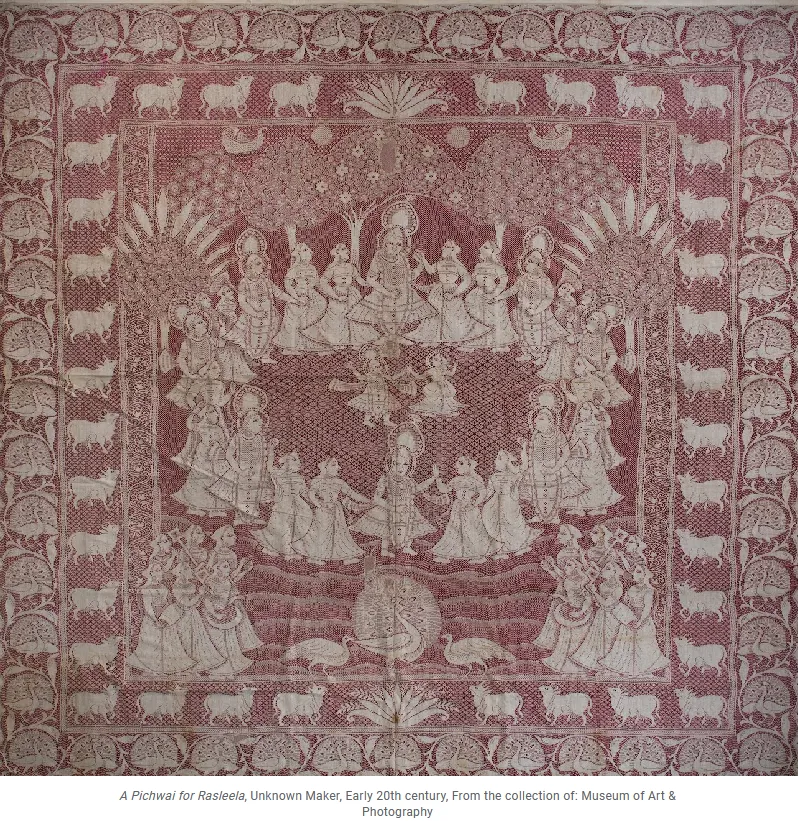
The posture of Shrinathiji most frequently painted figure in Pichwai paintings feature the leelas, tales and events in Lord Krishna’s life.Krishna is shown in different moods, body postures, and attire more commonly found on a cloth or paper. This very ancient form of art ,has passed on from generation to generation and it has a very devotional theme towards Lord Krishna.
The purpose of Pichhwais, other than its artistic appeal, is to narrate tales of Krishna to the illiterate. Pichwais are Among the most beautiful pigment painting on cloth in India are the temple hangings of the Vallabhacharya Sampradaya, a Krishna sect ,found in the late 15th century .These bright -coloured works adorn the walls and furnishings of a temple’s inner Chamber where lord Krishna resided .They are based on themes and are designed to create the appropriate atmosphere for a particular festival or season . Often called the ‘Art of God’, this traditional art form is quickly becoming popular among art collectors and enthusiasts. Pichwai art is a style of painting is supposed to be originated nearly 400 years ago in the holy town of Nathdwara in Rajasthan and illustrates Indian tales, poetry, literature, and myths hand-painted on silk, muslin or paper. When Nathdwara was set up and the painting traditions started, artists migrated from Kota and Kishangarh to join the atelier of the haveli.
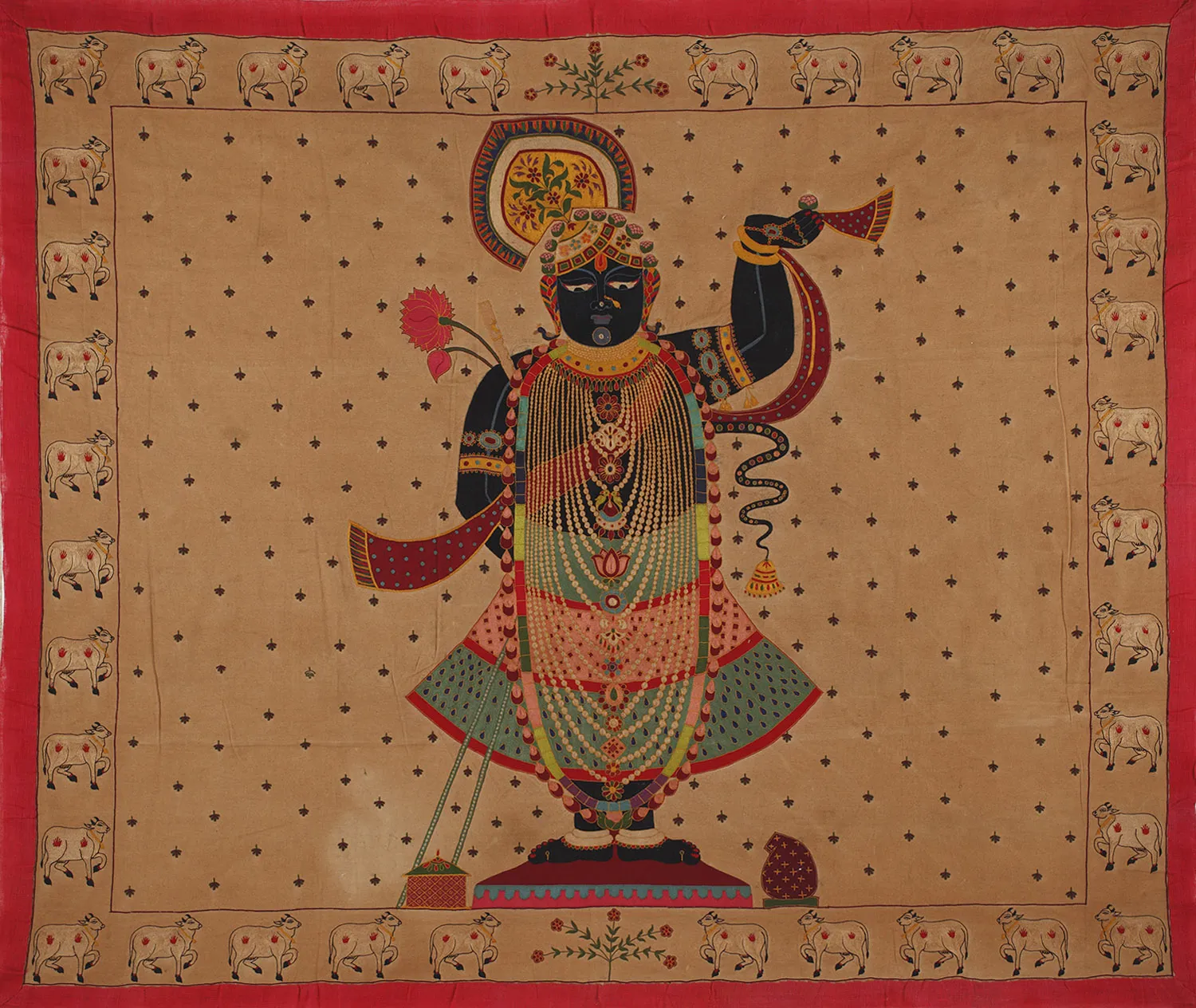
Nathdwara Painting refers to a visual culture painting tradition and school of artists that emerged in Nathdwara, a town in Rajsamand district in the Western state of Rajasthan in India and is the centre of Pichwai paintings . Nathdwara paintings are of different sub-styles of which Pichhwai paintings are the most popular. The Nathdwara school is a subset of the Mewar school of painting and is seen as an important school in the 17th and 18th century miniature paintings. The sub-styles of Mewar painting include Udaigarh, Devgarh and Nathdwara as important centers of miniature production. The temple of Shrinathji is believed to have provided a boost to this art activities in the town. Hundreds of artists live in Nathdwara and paint for their living .The Pichwai artists belong to two communities ,the Jangidas and the Adi Gauras .
These artists mostly live in Chitron ki gali (Street of paintings) and Chitrakaron ka mohallah (colony of painters) and make a close community with constant interaction. It is no wonder that many times a Pichhwai painting is a group effort, where several skillful painters work together under the supervision of a master artist. Most works produced in this style revolve around the figure of Shrinathji as a manifestation of Krishna and refer to the incident of him holding the Govardhan hill on his last finger. Each pichwai painting is considered a seva or an offering to the deity and hence personifies Shrinathji as a prince with jewels and luxuries, surrounded by the milkmaids, gopis. There are paintings that show the Lord in different costumes celebrating different festivals. Other themes like Mata Yashoda, Nandlal and Balgopal figures are also painted in this style. Some of the paintings are gem-encrusted.
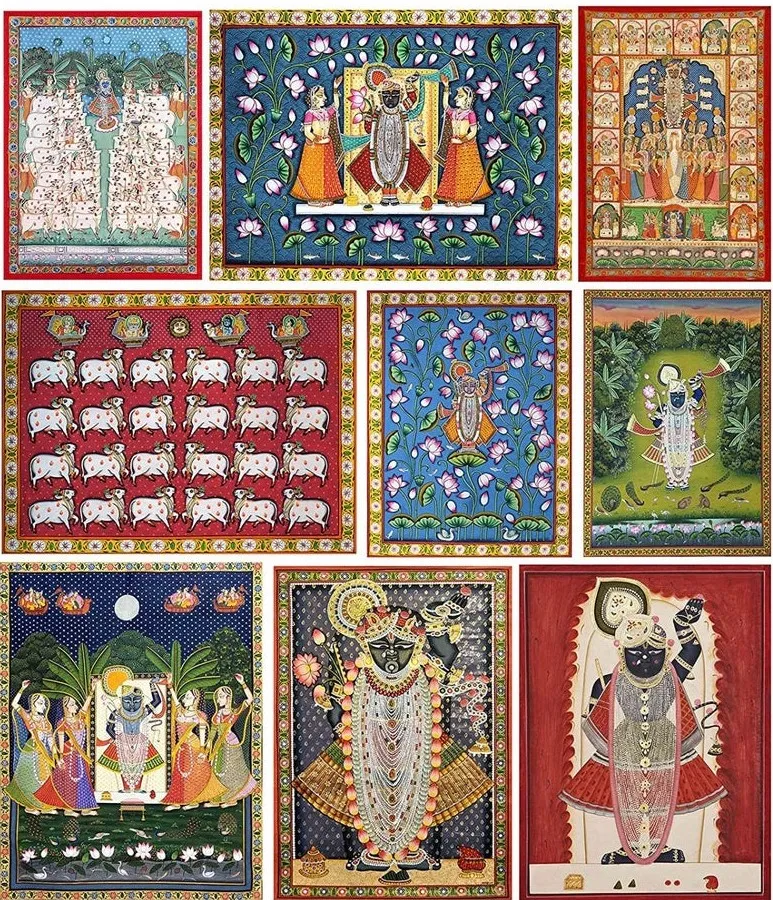
A collage of paintings
Soon enough, the lesser known art started attracting artists and art lovers from around the globe. And this is how Pichwais were discovered and found their home in hearts and galleries around the world.
The Making of Pichwai
Creating a Pichwai painting is an arduous task that can take several months. It involves the use of various pigments like metallic, organic, minerals and synthesized minerals. As discussed earlier Lord Shrinath is a child manifestation of Lord Krishna, the eighth avatar of Lord Vishnu, and a supreme God in His own right.When we first see a Pichwai, we are awed by its scale, its enormity. Then we start noticing its finer details- swirling patterns, crisscrossing grids, architecture, gopis, attendants, plants, animals, the moon, clouds, and miscellaneous recurring elements- which are all symbolic, metaphoric.
The colour of Lord Shrinath is almost always portrayed as Payne’s Grey or Black. This is because Krishna has been known to be a dark-skinned God. Interestingly however, Krishna in His adult form, is almost always shown as Blue. As Pichwai paintings are full of intricate embroideries, gem work, and fine detailing ,these paintings are not created through regular easel and paintbrushes but rather involves intricately strokes by hand while sitting on the floor.
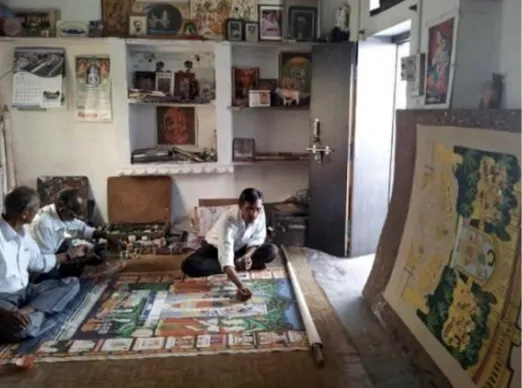
Firstly, the base material (Bhumibhand) is pasted on a plain surface and burnished for smoothness. Secondly, a sketch of the composition is done using either black or red ink. The natural stone colors are filled (Ranga Karma) using various dry and wet techniques. Lastly, a border or ‘hashiye’ is done of the painting.
True colours are the essence of Pichwai art. Natural paints made from gold, coal, silver, indigo, zinc, saffron and other minerals are used for the artwork. Artists grind the colours, take the dust and add tree gum to paint their piece.
Unlike other art forms, there is no possibility of touch-up in these paintings because of their fine detailing. With no room for error, Pichwai art requires immense skill, experience and patience. Over time and with the impact of commercialization, artists have started using a combination of natural and acrylic colours to give the atheistic touch to these paintings.
There is a wide range of techniques used in the making temple hangings. Although the most common and best known pichwai examples are paintings on cloth, the works may also be an applique, a combination of paintings and applique, printed, embroidered or brocade.
Earlier, Pichwais were painted on thick handwoven material, but now a thinner machine-made material is also used. Generally, the cloth used is white but it is not unusual to use black, blue or red fabric. In case of coloured fabric, gold and silver are predominant colours.
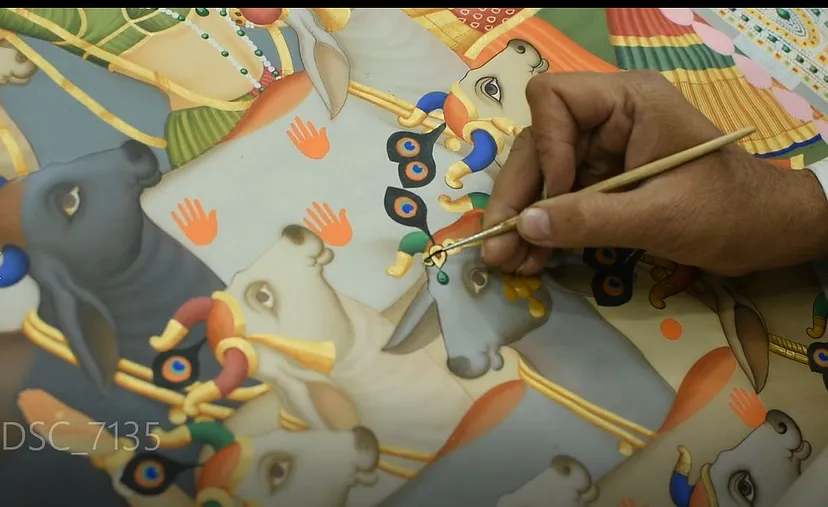
Colours : Pichwais are best remembered for their vibrant blues and greens and brilliant reds and oranges;the complete range of colour is used. Mostly, colours are made from the traditional mineral compound and vegetable extracts ,but nowadays commercial synthetic paints are being used.The natural dyes are kept by the artist in a dry ,rock -like form.When a colour is to be used,the pieces are ground and the powder is dissolved in water and thickened with a gum resin .
The colours used by the artists are :
1.sendur -Orange
2.Safeda-White
3.Kesari-Saffron
4.Nil-Indigo
5.Hinglu-Vermillion made from sulphide of mercury
6.Lilo- Bottle Green
7.Rav sena -Yellow ochre
8.Kati-Light Slate
9.Gulabi-Pink
10.Lal-Dark Red
11.Zangal-Copper Acetate
12.Khasni(Jambani)-Plum
13.Suva Pankhi-Parrot Green
14.Geru-Red Ochre
15.Selu-Emerald Green
16.Handmacha(also known as Hirmirchi)-Reddish Brown
17.Pilo-Yellow
18.Sai(also known as Syahi)black from lampblack
19.Gavgoli or Pyoriyellow made from cow urine
20.Asmani(also known as Lazvardi )-Lapis Lazuli
21.Jangali Ghero-Greenish Grey
and The use of pure gold in the paintings adds to their value and charm. For one painting, it may take 3–4 days to just prepare colour from pure gold.
Brushes: Nathdwara artists work with two types of brushes(kalams).The broad jara is made from goat hair or horse hair and is used in painting large areas .The detailed work is done with thin jhina made of squirrel tail.
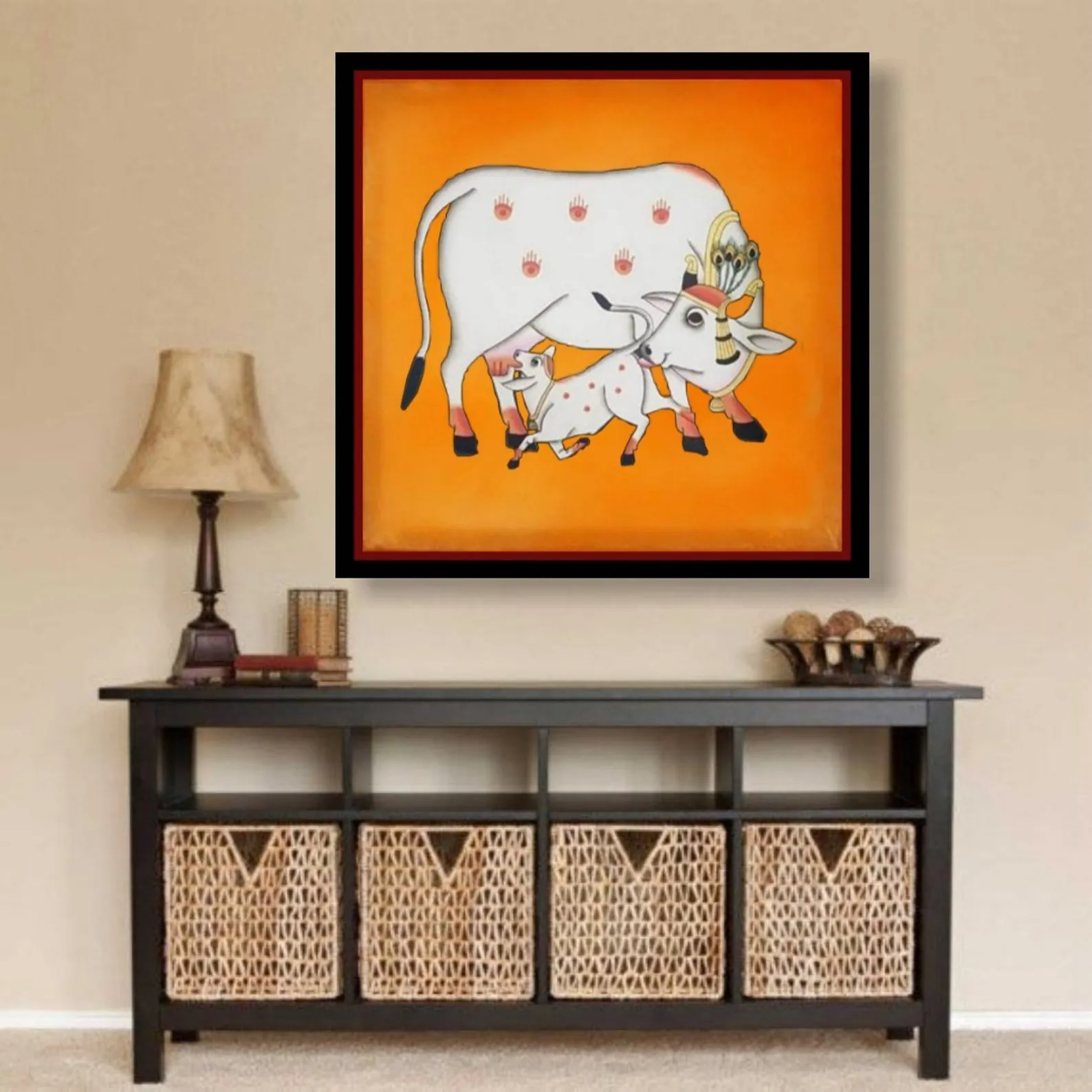
The procedure for making Pichwai involves the following steps:
Starching: The cloth is first starched using a Maida paste. This Prevents the colours from Running as well from bleeding through the material, after it dries, the cloth is ready to be block-printed.
Spacing: The spacing (Khakha Jamana) on the fabric is done very systematically. First, the outer limit for the border (par Ki boundary) which will contain the creeper motif (bel) is marked off with a coloured thread using a set square (Konia). The thread is dusted with charcoal or zinc white (safeda)and leaves a mark where it is placed. By the same method, the central portion, which will contain the main scene, is also outlined (pich Ki boundary)
Marking the Spaces: the center of the inner rectangle space is determined and marked, this central point governs the distribution of figures.
Sketching: The selection of sketching material is determined by the colour of the fabric. Zinc white is used on dark coloured cloth. On the white pieces, the sketching is done with the charred pointed tip of a twig from a tamarind tree. This rough sketching was call tipan. All the necessary corrections are made before the tipan is retraced with a brush dipped in sendur, (orange lead) or white paint, depending on the colour of the material. The sketch is lightly dusted with a piece of cloth and strarched again before the artists begin painting.
Painting: Then comes the painting of the figures and landscapes. When the initial colouring is finished, the work is polished by laying the cloth face down on a smooth rock and rubbing it from the reverse side with an agate stone (ghonta). The shading and detailed work on the figures and landscape follow. Among Nathdwara artists, this finishing is called Likhai.
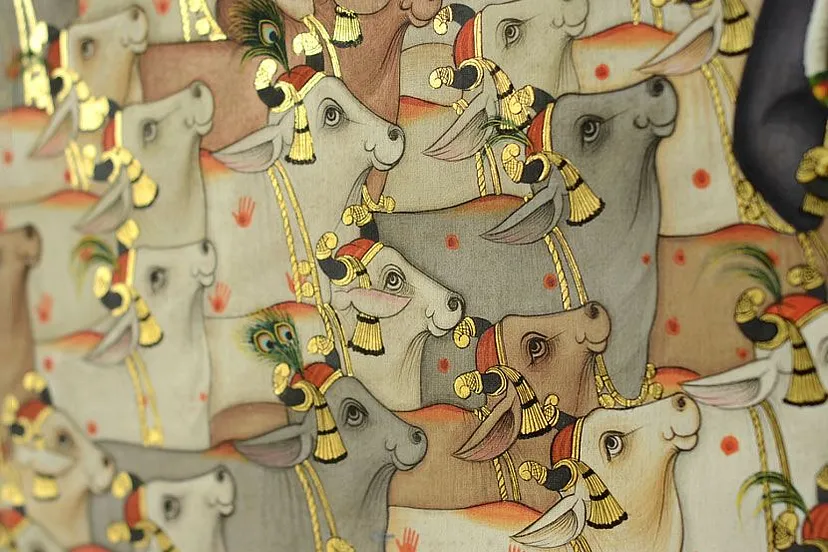
Ornamentation : At this stage, pearls (Moti Lagana) and rubies (naga Chuni) are added and the gold ornament are completed and rubbed with agate to give them a gloss. The final work in the figure is the addition of transparent garments. A light wash is used so that the undergarment remains visible (sari odhana). Gold butas are applied (Buti banana or chundari banana). The last step is the completion of the creeper motif in the border.
Annakuta Pichwai Painting
The type of Pichwai which is to be used on any occasion is governed by tradition. The Pichwai style is form of the Nathdwara School and is identified by characteristics features of large eyes, a broad nose and a heavy body similar to the features on the idol of Shrinathji. Generally, they are pictorial and illustrate the incident or even on which a particular festival is based. There are at least twenty four main celebrations, which are important to all the templates. The designs are commonly illustrated in the border scenes of painted Pichwais. These include the major Krishna festivals based on the well-known stories of the Bhagavata Purana and the verses of the bhakti poets as well as the anniversaries of historical events. In the case of the Krishna lilas these are idealized representations. However, these hangings, which depict actual events, are historical records complete with portraits of the participants.
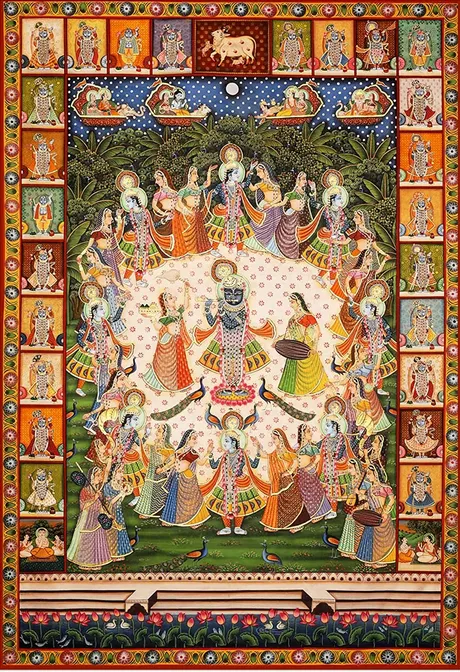
Although the majority of Pichwais are associated with particular festivals, a large member of hangings have seasonal themes and are not assigned to special days. These capture the mood of the season and provide relief from the scoring heat or piercing cold. They may be hung at any time during the appropriate season.
While the paintings depicting summer have pink lotuses, the paintings depicting “Sharad Purnima” comprise a night scene with the bright full moon.The seasonal restrictions are also closely followed. During the winter months, the scenes are not painted, but embroidered on heavy fabric or patterned in brocades. During the hot summer days the lightweight painted Pichwais with scenes of shady groves and cool streams are used in the shrine, Shri Nathji is surrounded with scenes of dense shaded trees, leaves in abundance with water or lotus ponds. With the coming of the monsoon season, the Pichwai is represented with peacocks joyfully dancing beneath the cloudy skies.
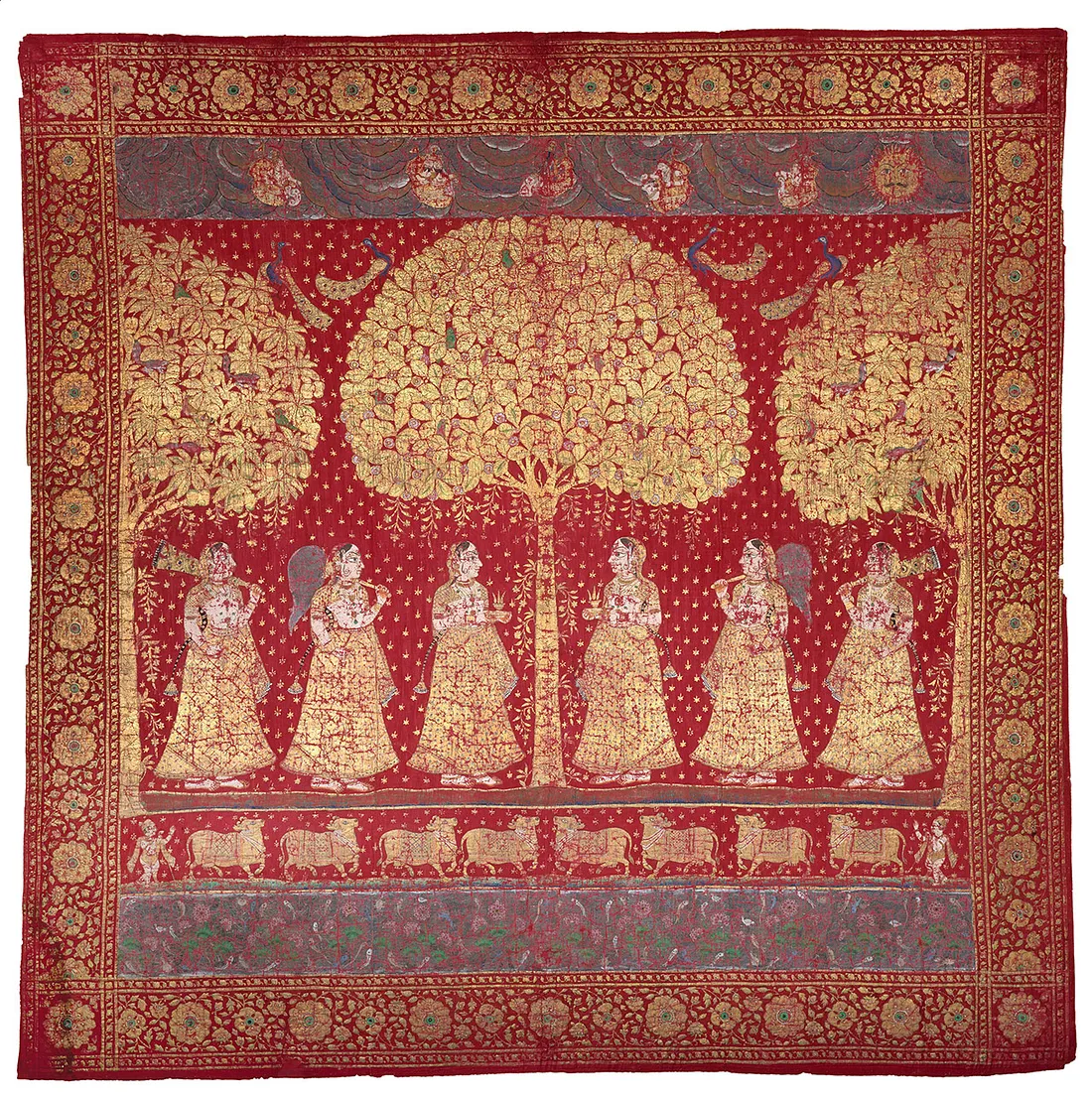
Usually, Krishna is shown standing beneath a blooming Kadamba tree with three or four gopis on either side of him. In addition to the Kadamba, there is a full or half mange tree behind each group of gopis. More commonly, Krishna’s presence among the milkmaids is merely suggested by a creeper, which twins around the trunk of the Kadamba. The posture of the Gopis play a major role in design.
They may dance for the Sharada Purnima or carry milk pots for the Daana Lila. When the background has raindrops and the sky is thick with clouds, it is the rainy season or a Varsha Pichwai. Each scene has a band of cows at the bottom of the hanging. The Morakuti Pichwai is filled with dancing peacocks. It is associated with the rainy season because at the first sound of thunder, the peacock spreads his magnificent feathers. The various other Pichwais are :
Ramnavami Pichwai
Nandmahotsava Pichwai :This tender scene described by Surdas is what is enacted on Nandamahotsava, where the vatsalya bhava or selfless parental love of Nanda and Yashoda is commemorated. On the occasion of the Nandamahotsav, celebrated the day after Janmashtami or the birth of Krishna, the doors of the inner sanctum remain open for darshan all day long. Shrinathji in his Navnitpriyaji swaroop is swung in a cradle by priests who dress up as Yashoda and Nanda to enact this scene. There are also celebratory dances with the temple servants dressed as the gopas and gopis of Vraj.As Krishna grows up, he becomes beloved of the whole village. Indulged as he is, he becomes a mischievous child, his love for milk and butter becomes legendary, and his charm grows steadily more irresistible.
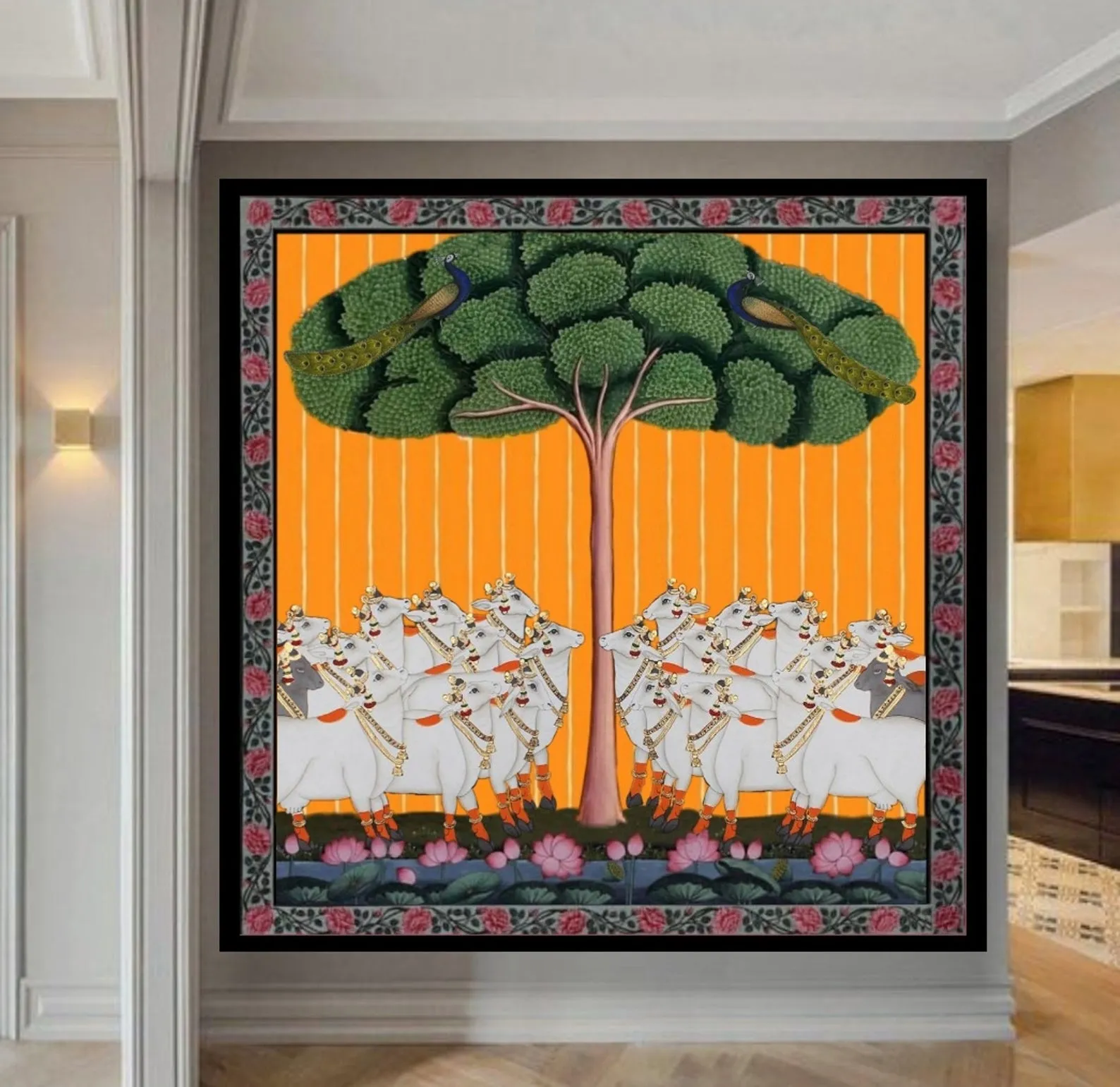
Daana Ekadashi Pichwai:The festival of Daana Lila is celebrated in August-September and has its origins in bhakti poetry where Krishna demanded milk and butter from the gopis as a toll for safe passage home. It is believed that this occurred in a valley in Mount Govardhana known as Daana Ghati, and while some pichwais depict the entire narrative and enactment of the gopis sharing their milk with Krishna, others only suggest the event with Shrinathji being approached by gopis bearing milk pots on their heads. At Nathadwara, the festival of Daana Lila, goes on for twenty days! Krishna grows gradually into the perfect cowherd: the one who all cows heed, answering to his flute as if in a state of intoxication.
Braj Yatra Pichwai
Sharad Purnima Pichwai :Ras Lila or Maha Rasa on the occasion of Sharad Purnima .Bhakti, the central tenet of the Pushti Marg doctrine is epitomised by the Ras Lila, where adolescent Krishna dances with his gopis. On a full moon night in the Vraj forest, by the flowing Yamuna, Krishna’s melodious flute calls out to the gopis like the pied piper, and they are forced to abandon everything to dance with him. The spirit of abandon and surrender that the Ras Lila evokes is the realization of bhakti: it represents the ultimate union of the soul with the Lord, a joining together in a cosmic dance. Thus, it is a theme dear to most patron-devotees and an extremely popular choice for pichwais.

Chourasi Swaroop Srinathji: The pichwai painting depicts the chourasi (eighty-four) swoops (forms) of Shrinathji. In Nathdwara, the ‘shringar’ of Lord Shrinathji is changed according to the time of day, different seasons and different festivals. The deity is decorated in a specific manner for each event. This painting depicts eighty-six different figures surrounding the central Shrinathji deity, of which eighty-four show different forms or swaroops of Shrinathji. The two at the bottom left and bottom right depicts the gosai, or the head priests, who imparted learnings of the Pushtimarg sect.
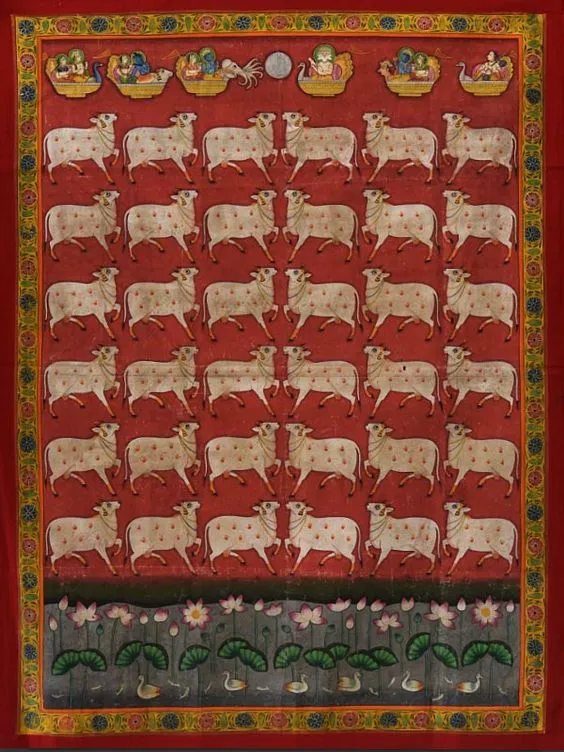
Annakuta Pichwai :The episode represented by this image relates to the autumnal offerings the villagers of Vraj were about to make to Indira, the nominal king of the Gods. Krishna suggested that worship instead be offered to the spirit of the mountain that sustained the pastures and woods that supported their livelihoods — and transformed into the mountain king in order to receive their offerings. The annual reenactment of this scene thus gains the name Annakuta or ‘mountain of food’. When a wrathful Indira unleashed a rainstorm in fury, Krishna vanquished him by lifting the mountain on the little finger of his left hand — captured by the key iconographic gesture of Shrinathji’s raised left hand.

Gowardhana Dharana Pichwai: Shrinathji and his this Posture — is the Dominant Figure in Pichwais .Krishna, as a child, lifted Govardhan Parvat (hill) on his little finger for seven days, and safeguarded the people of Vrindavan from Lord Indira’s devastating thunderstorms. Right hand typically rests on his waist, or is lowered in an act of blessing.
Gopashtami Pichwai :The Gopashtami festival takes place in the late autumnal months, and marks the elevation of Krishna from a younger herders of calves to a full cowherd. Cows are adorned with henna and sindur hand prints, peacock plumes and with bells around their necks. At Nathadwara, the cows, decked in their finest, are brought into the haveli.
Morakuti(monsoon)Pichwai : Pichwais for Morakuti, as seen below, depict peacocks with crested crowns dancing in full abandon in the rainy season. Named after a small village in Vraja, near the birthplace of Radha, where peacocks abound — these pichwais mimic the ras lila, or Krishna’s dance with Radha and the gopis.
Varsha Pichwai : Varsha or Vrikshachari pichwais evoke Krishna as a vrikshacharya or tree dweller. He is only symbolically represented in the painting therefore, usually through the kadamaba tree, while in anticipation of his arrival gopis appear on either side of the tree carrying offerings of garlands, peacock fans, flowers and fly whisks.
Winter Pichwai
Different Scenes Depicted in Pichwais
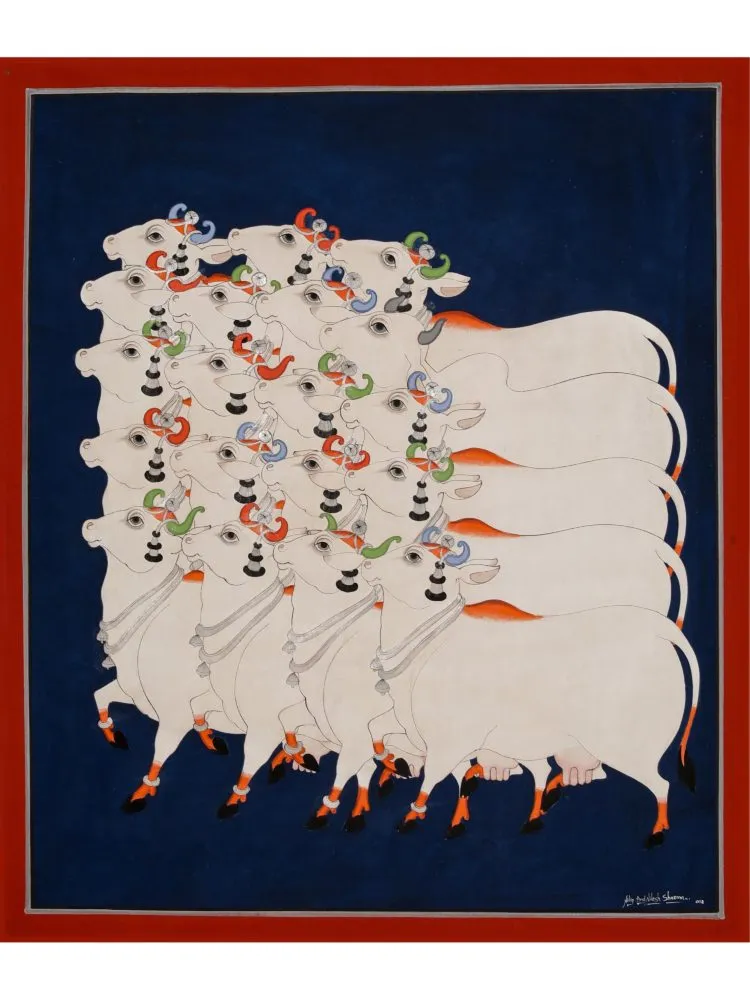
Different seasons and events in Lord Krishna’s life are depicted in pichwais. Radiant pink lotuses adorn pichwais hung in summer, whereas peacocks are painted on pichwais used at temples during the rainy season.
Influence of Other Styles

Unlike the pigment-painted Pichwai, the other types of hangings such as embroidered or applique pieces were not the products of school which specialized in Pichwai. They were the works of craftsmen who excelled in sewing, weaving, or embroidery. The applique Pichwais were made by tailors employed by temples on occasions, the tailor worked in collaboration with an artist who sketched the pattern for the figures and later added the painted details.
The Zordozi hangings, which occupied an important position in the main house of the Vallabh sampradaya, were also the works of tailors. Gold or silver metal threads were stitched to satin or velvet with thin silk threads giving the works the appearance of true embroidery.
Brocade hangings are quite popular because they are well -suited to the winter weather. Such pieces are made by professional weavers on special order.
Themes of Painting
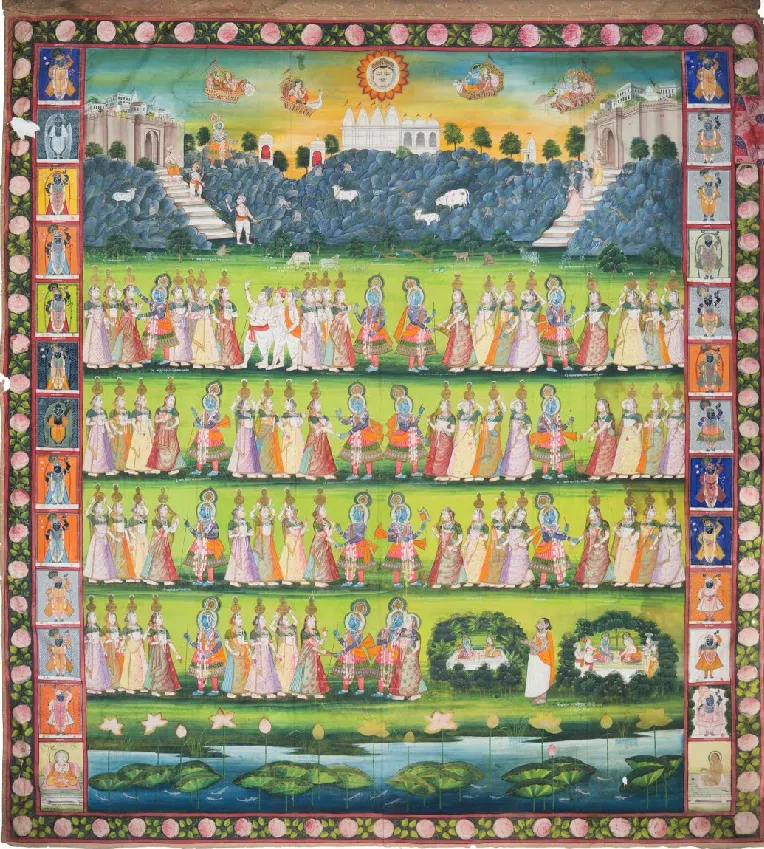
Lord Krishna is often depicted as Shrinathji in Pichwais,. He is considered as an evidence of 7-year-old child form of Lord Krishna.Other common subjects found in pichwai paintings are Radha, gopis, cows and lotuses. Festivals and celebrations such as Sharad Purnima, Raas Leela, Annakoot or Govardhan Puja, Janmashtami, Gopashtami, Nand Mahotsav, Diwali and Holi are frequently depicted in Pichwais. A Pichwai may be handpainted, printed using hand block techniques or woven using embroidery, dabka, or zardozi work.
Redefined Contemporary Pichwai
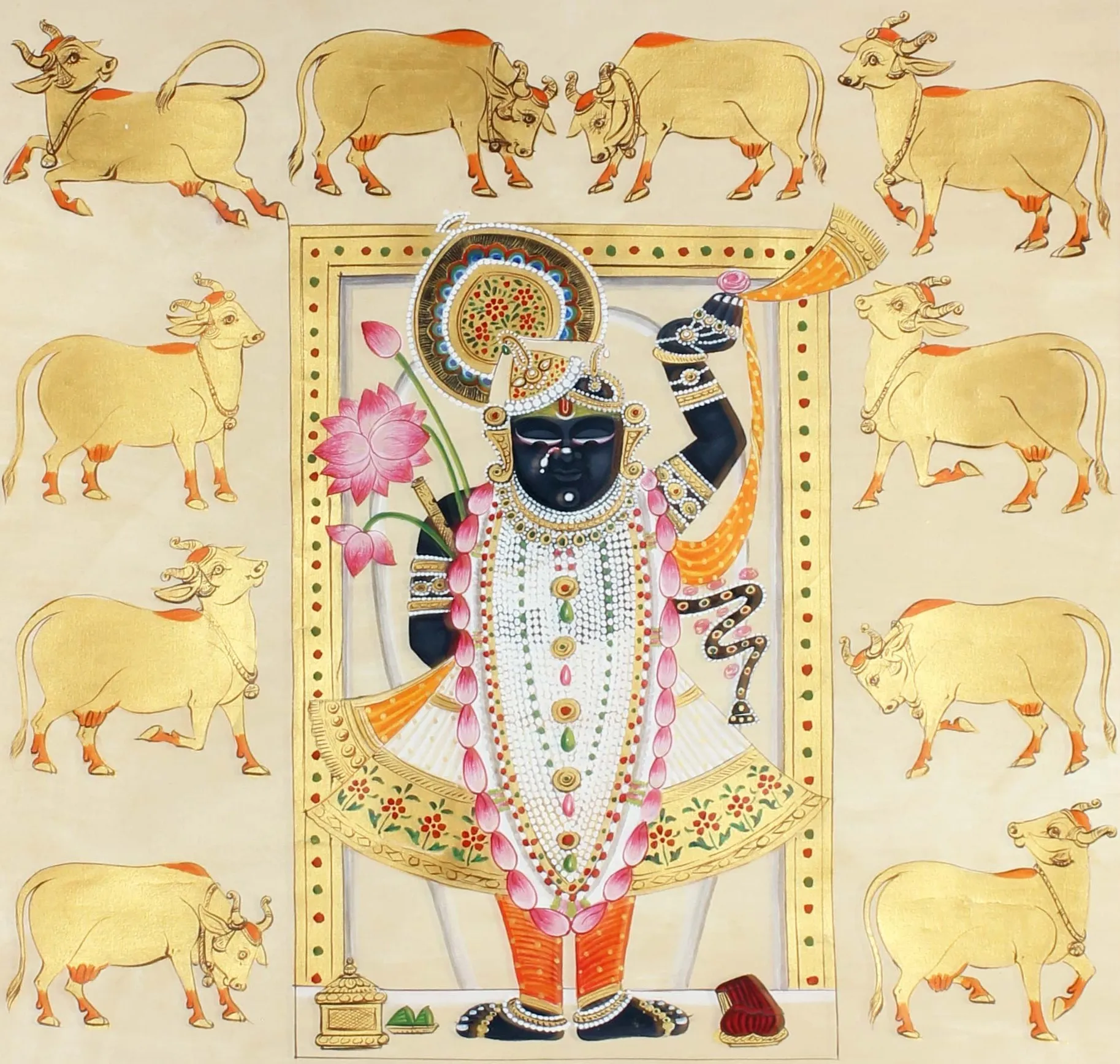
Steeping in tradition, Pichwai art depicted the moods of the Lord on the canvas. However, with a change in mindset towards art and aesthetics, this art form is gradually evolving incorporating the contemporary elements!
To cater to the requirements of customers for decorating their modern homes, the size and structure of the paintings are reduced from 10–12 feet to about 2–4 feet now.
Also, the subject has undergone a transformation owing to the audience’s changing demands- artists are creating contemporary renditions of this traditional art form in terms of composition, colours and features (sharp nose, round/oval-shaped eye) of the deity.
Charting a new path, various artists have started painting on social issues such as saving trees, water to generate awareness and create a niche for their artwork.
Apart from this, Pichwai art is now being used on clothes such as saree and various artistic home decor items with vibrant colours including hand-woven tapestries which have received good response from the customers. They have become the main export of Nathdwara and are in much demand among foreign visitors in the area.
Like every art, Pichwai painting has its own beauty and meaning!These paintings of love and happiness, created with utmost devotion by artists invoke joyous feelings and positive vibes.What is important is not just to preserve this Rajasthani traditional art form but also to encourage its contemporary form!
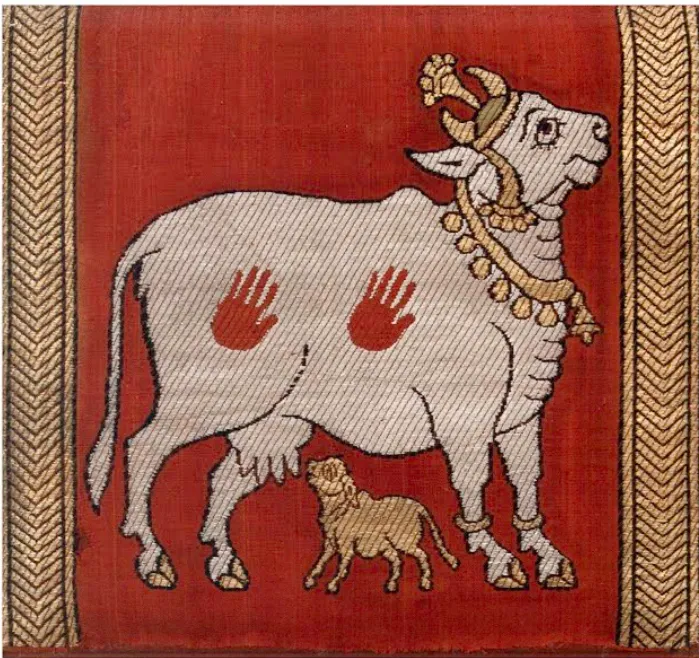
The Pichwais were made on woven fabric and consisting of 24 rectangular compartments that are each complete paintings on their own. They mostly depict rituals, or adornment of the Lord, adjusted according to the seasons and festivals. These, when mixed with different kinds of folk and other art school forms over the years, have transformed and evolved into diverse styles which are contemporary renditions of the originals made at different points in history and today more in contemporary ways to appeal the generations of Today.
Unlike miniatures in the Mewar School, they do not stick to a realist time frame or a sense of perspective. The paintings are flat and favour symbolism over realistic storytelling, to appeal to younger collectors. Some paintings encompass geometrical compositions, while still others employ decorative borders and new subjects to fit contemporary aesthetics. This may feel like a loss in translation in some cases, but brings out brilliant new perspective in others.
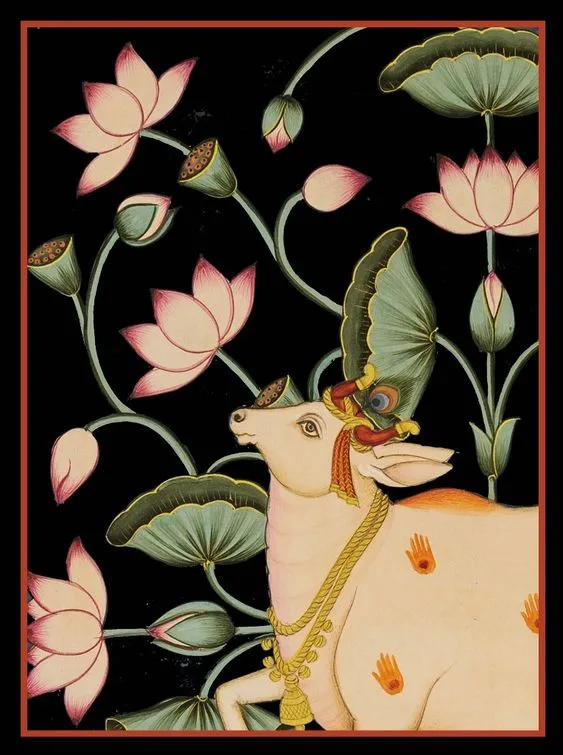
Over time, pichwais also found a place in the homes of art connoisseurs, owing to their visual appeal. With the evolution of popular art and technology, Pichwai art is becoming more relevant for younger art enthusiasts and collectors in the country as well as the rest of the world.
Like several other traditional Indian art forms, the art of Pichwai is also dying, and requires recognition and revival. With the change in mindset towards art and aesthetics, there have been significant changes in the traditional art. The size of the paintings has reduced from 10–12 feet to about 2–4 feet to make them suitable for modern homes and not just temples or religious spaces. Apart from the physical size and structure of Pichwais, the subject, too, has undergone a transformation — artists are creating contemporary renditions of the Pichwai, in terms of composition, colours used, and features of Shrinathji. The importance of godly figures and their tales have been an inseparable part of Indian culture for ages. The traditional art form of the Pichwai holds the baton for Lord Krishna paintings for thousands of years now. With the numbers of discerning takers waning, the intricate art of Pichwai finds itself pitted against the newer modern and more contemporary forms which flood the market.
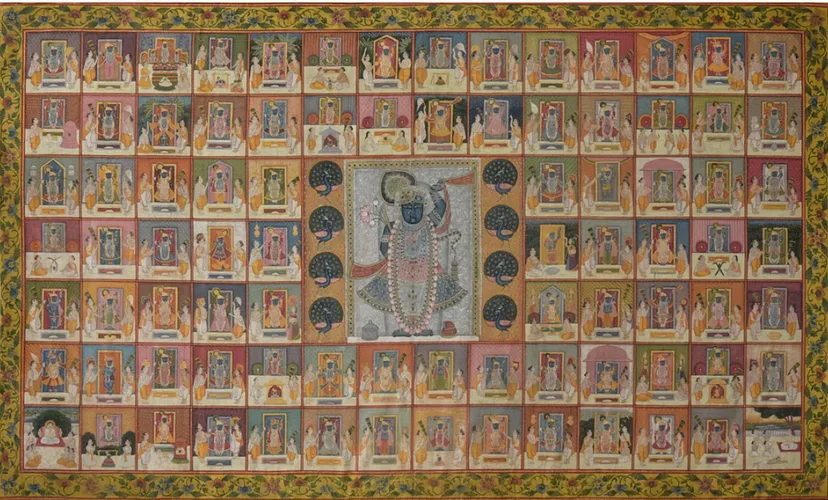
For the traditional artists of Nathdwara, Pichwai is a form of art and living. There are only ten to twelve original Pichwai artists left in Nathdwara now, all of whom also paint the newer forms that are now in demand. A good Pichwai can take an artist up to nine months, or even a year, to complete and comes at a price of INR 1,00,000 or more. The older ones, which are part of private collections, are rarely available for sale and are the preserve of a select few. The art form is being reimagined in contemporary forms and making waves in the established art circuits of the world. The traditional form, however, needs to be revived and restored globally to preserve its delicate workmanship and conserve its heritage.
We must support the community, and at the same time, thoroughly enjoy this royalty, this luxury of seeing this art being made fresh, exclusively, and diligently.
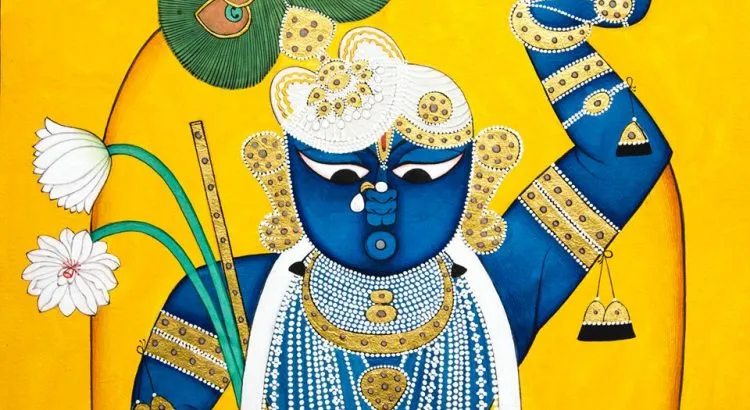
Finally ,To the Portal of the Lord of Nathadwara — come many offerings. Here keep continually pouring in, like ‘the spices of the isles of the Indian archipelago; the balmy spoils of Araby the blest; the nard or frankincense of Tartary; the raisins and pistachios of Persia; every variety of sweet preparation… with which the god sweetens his evening repast… ; the shawls of Kashmir, the silks of Bengal, the scarfs of Benares, the brocades of Gujarat…’ But, as ancient texts keep reminding one, there is no offering greater than that of devotion. And, no matter what they received in payment or as prasada, the makers of the great pichwais appear to have brought devotion to their work, their great skills and their artistic vision apart… can be clearly seen in these Paintings.
The magic world of Rajput painting being ‘not unreal or fanciful, but a world of imagination and eternity, visible to all who do not refuse to see with the transfiguring eyes of love.
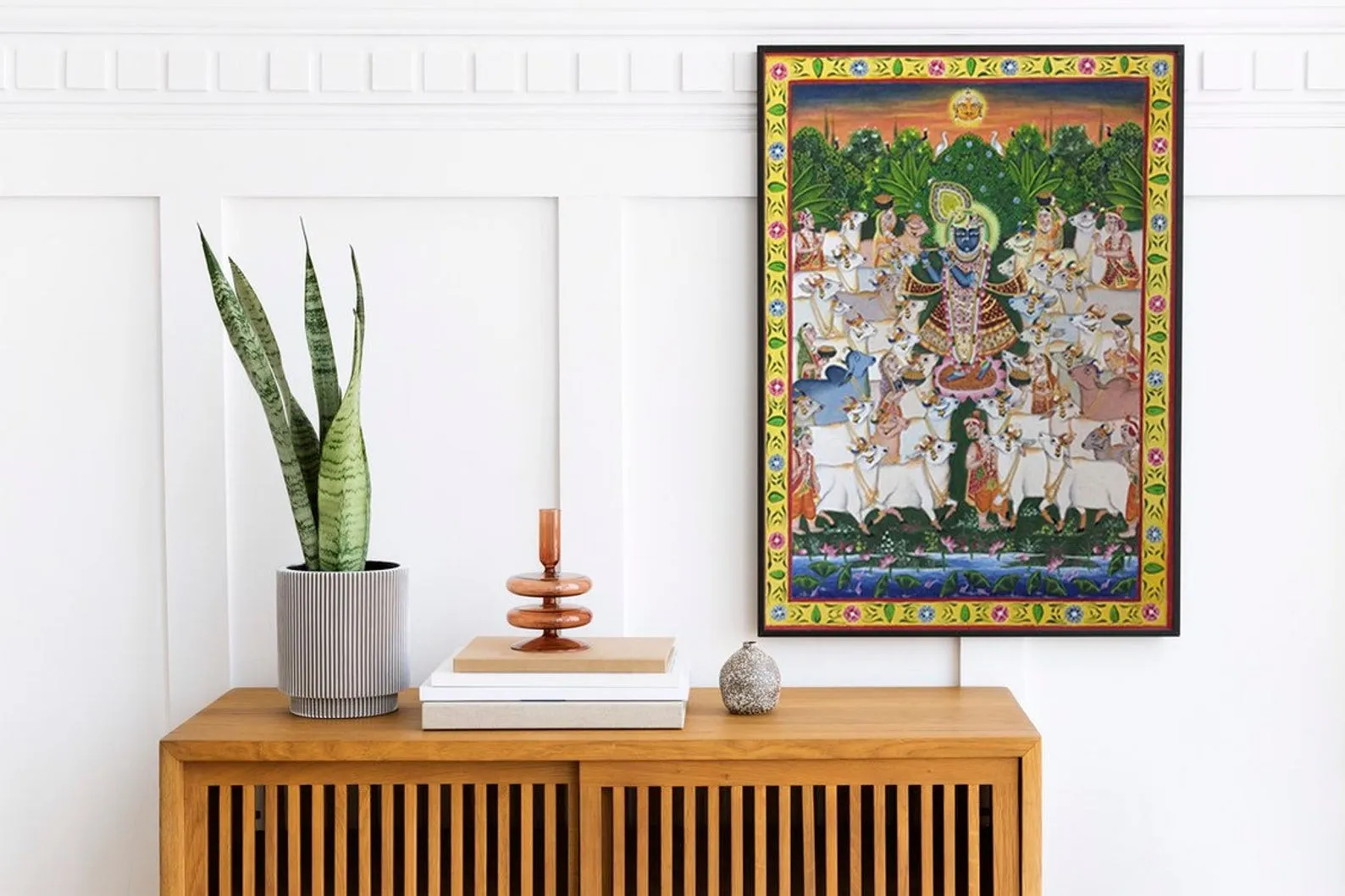
The author of this article is Dr. Vinita Mathur (vinita @dezyneecole.com),she is an esteemed educationist, and the visionary owner of a prestigious college ,Dezyne École College . Her intellectual prowess, dedication to education, and innovative leadership have made her a prominent figure in academia and a source of inspiration for countless students and educators alike.
Through her scholarly pursuits, educational leadership, and commitment to empowering students, she has left an indelible mark on the educational landscape.